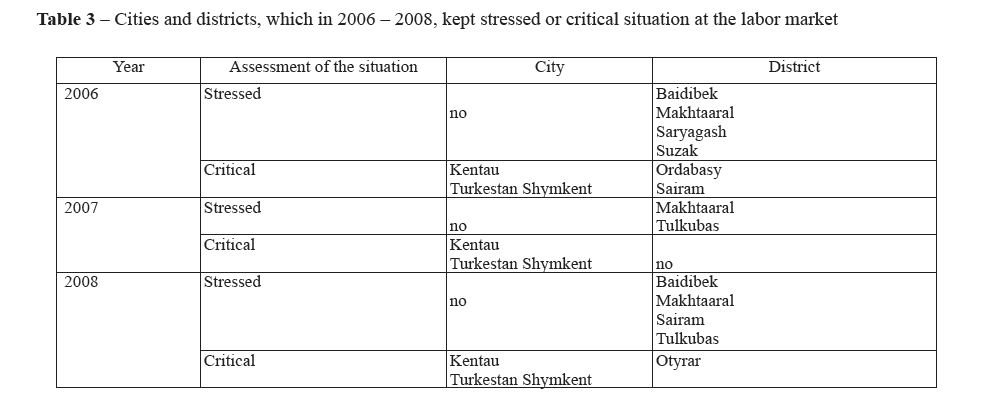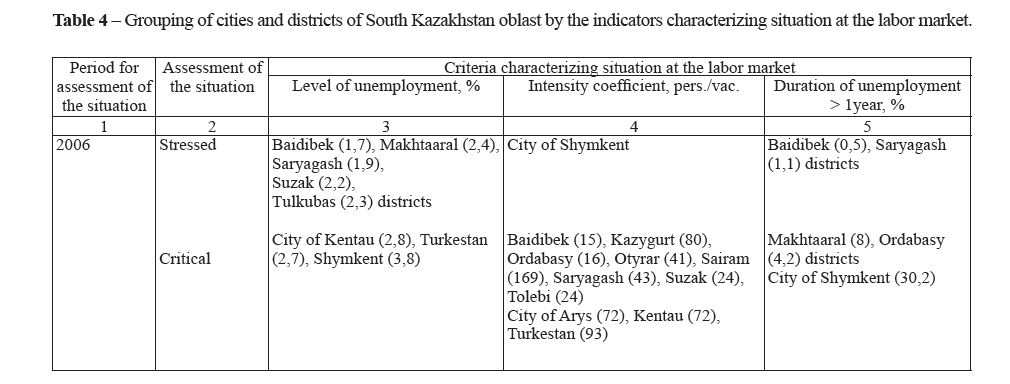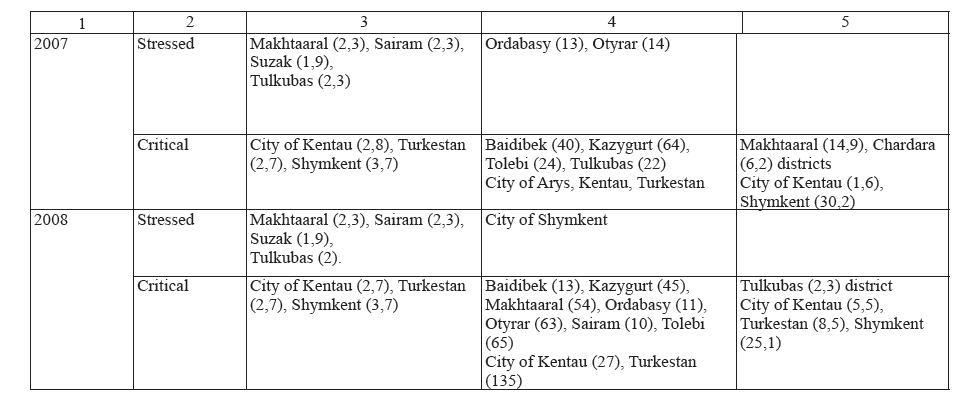Heterogeneity of economic space, irregularity of regional development are characteristic for any state as a social-economic system. Aim of the regional policy is consideration of interregional differences to determine potential and directions of the social-economic development.
There are various approaches to the typology of negative regions and their crisis groups.
Characteristics in the level of employment and formation of labor market in regions propose opportunity of the regions’ grouping by interrelated social-economic factors.
The article considers analysis indicators of the labor market. It defines criteria to detect regions with critical situation at the regional labor market. It gives calculations on administrative-territorial entities of SKO in a crisis period. It has defined interval scales of the administrative-territorial entities’ distribution by condition of the labor market depending on the critical situation at the market with a view to detect depressive regions.
Considerable attention in the economic literature is paid to the problem of study and assessment of situation at the labor market and its territorial transformations. The most of scientists propose to define true position on situation at the labor market, using complex of indicators.
Some economists for these aims propose to use the next indicators, such as level of unemployment, number of registered jobless with a view to one closed position, mean time of the registered unemployment, share of the jobless registered more than a year, share of all provided by job among the registered (in average for a month) [1].
Some scientists in the quality of indicators use level of unemployment, number of jobless for one declaratory vacancy, mean time of unemployment and scales of concealed unemployment [2].
A work “Regions with stretching situation at the labor market” uses only two indicators, such as level of unemployment and its duration. “Recommendations on determination of criteria and detection of regions with critical situation at the labor market” besides traditional indicators of the level of unemployment and intensification coefficient to detect territories with critical or stretching situation, propose to use six more indicators. Among them two demographic, such as population growth of the region by human migration and share of able-bodied citizens in the general population of the region [3]. Two economic, such as share of unprofitable enterprises and number of part-time workers. Two, reflecting living standards of population, such as per capita income of population and index of consumer prices. “Methodical recommendations …” [4] recommend determine criticality level at the local labor market on the ground of using the whole system of parameters consisting of 10 indicators. At that, the essence of each of these indicators is revealed and their “critical” meanings are given.
In a crisis period, a situation at the regional labor market can be considered as a critical only when other interconnected indicators of the labor market’s condition (number of jobless with a view to one vacancy, duration of unemployment, etc.) are also significantly worse of their values by the republic at the level of officially registered unemployment, significantly exceeding its mean value by the country. Two circumstances, very important for decision making overall by the country, are considered in the given determination of the stretching or critical labor market condition of the region.
The first of them is connected with “baseline”, i.e. average by the region the labor market condition that allows in a definite measure confine number of regions, which labor market can be referred to the number of crisis. Therefore, confine expenses necessary for funding of measures to render appropriate support. The second circumstance is acceptance of its stagnation in the quality of necessary feature of the labor market that is in the crisis situation, i.e. high enough share of jobless who cannot find a job during a year and more.
To refer one or another territorial formation to the regions with critical situation at the labor market, it is necessary to establish definite criteria, features, which would allow give appropriate assessment of the situation in different regional (and inside them) labor markets of the country. Besides, such criteria would give opportunity to classify the labor market depending on their situations.
To analyze the labor market condition in a definite period, there is need in approach to the classification problem of regions by separating three possible situations at the labor market, such as stable, stretching and critical. Separation of the stable situation is provided by need to evaluate strong functioning sides of regions with specified situations; to define similar measures focused on improvement of situation with the critical situation by the labor market subjects; more efficient use of means in the administrative- territorial separations with satisfactory situation at the labor markets and increase in investments to the administrative-territorial separations with wrong situation.
The unemployment level, duration of unemployment, coefficient of unemployment or capacity of the market can be chosen as indicators with the help of which one or another administrative- territorial separation can be referred to one of the specified situations. Deviation degree of the indicator of the definite region from mean value of the indicator by the region on a higher hierarchy level is used at that to refer one or another indicator to one of the separated groups, characterizing situation at the labor market. If it will be necessary to study situation at the labor markets of districts, cities, rural and agrarian administrations or settlements, then in the quality of the main, it is necessary to take overall region (oblast). A value of the criterion. i.e. deviation from the mean by the overall region cannot be equal for the whole group of indicators proposed in the quality of assessment of the labor market situation. Since in itself, possible variation of the specified indicators is significant enough, a change least of all is possible (in transfer from one administrative-regional unit), duration of unemployment. In a greater or lesser degree, the unemployment level indicator. And to a large extend, an indicator characterizing coefficient of intensity (capacity of the market), characterizing number of jobless for one vacancy place.
We have carried out calculations in the most labor-excessive region, South Kazakhstan oblast (Table 1). So, carried out by us grouping of the administrative-territorial entities by value of criteria considered during crisis period of 2006 – 2008, showed the following. Duration of unemployment in more than a year, in this period, changed in 2008 from 0 to 36.9% in the city of Shymkent in mean by the oblast in 6.7%; level of unemployment from 4.6% in Makhtaaral (2007) up to 11.3% in the city of Shymkent (2006); coefficient of intensity (capacity of the market) from 0% in Sairam (2007), Chardara districts (2006 – 2008) and Kentau town (2008) up to 22.1 people for one vacancy in Sairam district (2006).
Table 1 – Criteria for assessment of situation at the labor market of South Kazakhstan oblast.

Interval scales to refer a region to one of the proposed situation at the labor market were developed on the ground of such grouping by each of three considered criteria.
However, criteria of stability of the situation by all indicators are different by the level of unemployment – from 2,0 to 4,1 from mod-oblast level, by the intensity coefficient – from 4,35 to 13,3, by the duration of unemployment in more than a year – from 0 to 25,1 times. Respectively criteria for intensification assessment and criticality of the situation by all three indicators are varied.
Using proposed approach, we have carried out grouping of cities and districts of South Kazakhstan oblast, where for the studied period, the considered indicators can be evaluated as stressed or critical (Table 2). Territories, where these three indicators were stable, were not considered.
Table 2 – Interval scales for distribution of the administrative-regional units by their condition at the labor market

The attempt to analyze the results do not give direct opportunities to evaluate situation at the market of one or another administrative units of oblast, as there are practically no one city or district, where all three analyzed indicators were only critical. To evaluate situation at the labor market of one or another territorial formation as a whole, we propose the following approaches: 1) if by two of three considered indicators the situation is characterized as a stressed or critical, then the situation as a whole by city or district will be evaluated similarly; 2) if by one of three indicators the situation is characterized as a stressed, by the second as a critical, and the third indicator does not come to the pointed situations, then in this case as a whole by city or district, it will be evaluated as a stressed. The results on the situation’s assessment at the labor markets of cities and districts, carried out based on the given approach are presented in Table 3.
According to data of Table 4, the most complex situation in local labor markets of South Kazakhstan oblast in the crisis years was formed in the next cities and districts of the oblast, respectively, Kentau, Turkestan, Shymkent, Baidibek, Makhtaaral, Sairam, Tulkubas.
In development of measures to manage by the labor market of the oblast in general, there should be paid special attention exactly to the pointed territorial formations, on the ground of analysis of social-economic situation in these cities and districts with a view to detect (and further removal) causes and factors, being the imperatives for the situation’s escalation at the local labor markets.
Table 3 – Cities and districts, which in 2006 – 2008, kept stressed or critical situation at the labor market

To our opinion, as applied to the local labor markets under the regional formations, the most reasonable is separation of three possible situations (stable, stressed, critical) on the ground of three indicators of unemployment level.
Table 4 – Grouping of cities and districts of South Kazakhstan oblast by the indicators characterizing situation at the labor market.


The presented classification of territories by the situation’s edge degree at the regional labor markets can be completely used for analysis of the situation in general by the country with a view to detect those territories, which cannot be managed without finan- cial support from the center.
Application of the criteria system in a defi- nite measure allows give assessment of the situation of the labor market of a region, compare it with the situation in the country in general and more reasonably approach to the development of programs on support of population’s employ- ment, decrease in unemployment, coefficient of its intensity and duration in a region considering its sectorial, sex and age, professional and other characteristics.
References
- Mataev T.M. Regionalnoe razvitie i problemnaya territoriya. – Almatyi, 2003. – 124 s.
- Garsiya-Iser M., Golodets O., Smirnov S. Kriticheskie situatsii na regionalnyih ryinkah truda // Voprosyi -1977.
- Tkachenko A., Matyitsina N.A., Yanovskaya Yu.M. Rekomendatsii po opredeleniyu kriteriev i vyiyavleniyu regionov s kriticheskoy situatsiey na ryinke truda. – M.: Progress, 1994-1995. – 118 s.
- Metodicheskie rekomendatsii o poryadke organizatsii rabotyi organov sluzhb zanyatosti v usloviyah massovogo vyisvobozhdeniya: utverzhdenyi prikazom # 161 FSZ Rossii ot 30.12.93g.